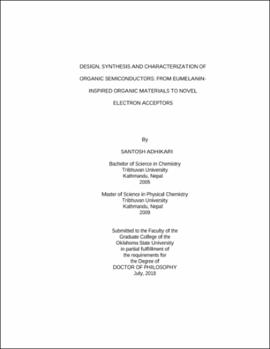| dc.contributor.advisor | Nelson, Toby L. | |
| dc.contributor.author | Adhikari, Santosh | |
| dc.date.accessioned | 2023-03-13T21:10:03Z | |
| dc.date.available | 2023-03-13T21:10:03Z | |
| dc.date.issued | 2018-07 | |
| dc.identifier.uri | https://hdl.handle.net/11244/337092 | |
| dc.description.abstract | Eumelanin, the black-brown variety of natural pigment melanin, is a fascinating material owing to its multifunctional physicochemical properties, such as broad-band absorption spectrum, antioxidant and free radical scavenging behavior, strong nonradiative relaxation of photoexcited electronic states and metal chelating properties. Further, biocompatible and biodegradable nature, peculiar physicochemical properties and intrinsic antimicrobial activities make eumelanin a promising material in bioelectronic and biomedical fields. Here, the Eumelanin-inspired indole core has been utilized to synthesize bio-inspired organic semiconductors (OSCs), sensors, and antimicrobials.In the field of organic semiconductors, both p-type and n-type materials are equally important. While p-type OSCs have seen a dramatic rise in performance over the last decade, n-type OSCs, in general, still lag behind p-type OSCs. This lack of high performance n-type OSCs is mainly related to lower stability, difficulties in synthesis and less availability of electron deficient building blocks that can be used for making n-type OSCs. Both types of OSCs with high performance are required in order to fabricate high-performance complementary circuits or p-n junction devices. Thus, there is a critical need for exploration of new building blocks for making novel n-type OSCs with improved electron mobility, material stability both under processing and operational conditions, and ease of synthesis. Benzo[1,2-b:4,5-b0 ]dithiophene-1,1,5,5-tetraoxide (BDTT) has seen less utility as a building block to make n-type OSCs despite it being an electron poor heterocycle with promise for development of n-type materials. Difficulties in functionalizing BDTT via carbon-carbon cross coupling reactions and often in low yield is one likely reason for the lack of utilization of BDTT in OSCs. This dissertation will report the successful functionalization and utilization of BDTT for the synthesis of n-type OSCs | |
| dc.description.abstract | In past few years, organic conductive fibers have emerged as an attractive as well as promising class of materials for realizing non-metallic electrodes for different clinical applications. This is because these materials are biocompatible, better integrated, easier to fabricate, lightweight and have limited magnetic resonance imaging problems compared to the metallic electrodes. This dissertation will highlight novel organic conductive fibers that have been fabricated by a facile, economical, and scalable method by using conductive ink prepared from the two intrinsically conductive materials - poly(3-hexylthiophene) and single walled carbon nanotubes - and these conductive fibers have been utilized as non-metallic electrodes for recording skin surface biological signals. | |
| dc.format | application/pdf | |
| dc.language | en_US | |
| dc.rights | Copyright is held by the author who has granted the Oklahoma State University Library the non-exclusive right to share this material in its institutional repository. Contact Digital Library Services at lib-dls@okstate.edu or 405-744-9161 for the permission policy on the use, reproduction or distribution of this material. | |
| dc.title | Design, synthesis and characterization of organic semiconductors: From eumelanin-inspired organic materials to novel electron acceptors | |
| dc.contributor.committeeMember | Blum, Frank D. | |
| dc.contributor.committeeMember | Bunce, Richard A. | |
| dc.contributor.committeeMember | El Rassi, Ziad | |
| dc.contributor.committeeMember | Borunda, Mario F. | |
| osu.filename | Adhikari_okstate_0664D_15843.pdf | |
| osu.accesstype | Open Access | |
| dc.type.genre | Dissertation | |
| dc.type.material | Text | |
| dc.subject.keywords | antimicrobials | |
| dc.subject.keywords | conjugated polymers | |
| dc.subject.keywords | melanin | |
| dc.subject.keywords | eumelanin | |
| dc.subject.keywords | organic conductive fibers | |
| dc.subject.keywords | organic semiconductors | |
| thesis.degree.discipline | Chemistry | |
| thesis.degree.grantor | Oklahoma State University | |
